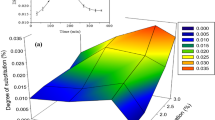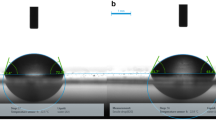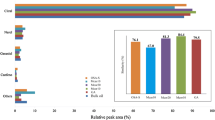Abstract
We investigated the molecular characteristics of 4-α-glucanotransferase (4αGTase)-modified rice starch (MRS) and corn starch (MCS) gels and the NaCl release properties depending on their mechanical properties. Also, encapsulation efficiency (EE) and oil globule size of water-in-oil-in-water (W/O/W) emulsions containing MRS or MCS in the inner aqueous phase (W1) with NaCl as a model core material were measured after preparation and 14 days of storage. The characteristics of MRS and MCS were examined by analyzing amylose content, molecular fine structure, microstructure, and mechanical properties to better understand their associations with emulsion stability. At 20 % concentration, the gel strength of MCS (~105 pa) was greater than that of MRS (~103 pa) as MCS had higher apparent amylose content than MRS. The rate of NaCl release from the gel was highly correlated with the gel strength that depended on the type and concentration of the enzymatically-modified starch. As the gel strength increased, EE of freshly prepared and stored W/O/W emulsions increased. Osmotic swelling of NaCl-containing W/O/W was significantly reduced with the incorporation of the modified starch gels in W1 phase. These results indicated that physicochemical properties of 4αGTase-modified starch gels in W/O/W emulsions largely affected the encapsulation efficiency and stability of the emulsions, which could be utilized to formulate W/O/W emulsions with improved stability and the potential for broader applications.







Similar content being viewed by others
References
Aditya, N. P., Aditya, S., Yang, H., Kim, H. W., Park, S. O., & Ko, S. (2015). Co-delivery of hydrophobic curcumin and hydrophilic catechin by a water-in-oil-in-water double emulsion. Food Chemistry., 173, 7–13.
Benichou, A., Aserin, A., & Garti, N. (2004). Double emulsions stabilized with hybrids of natural polymers for entrapment and slow release of active matters. Advances in Colloid and Interface Science., 108–109, 29–41.
Boland, A. B., Buhr, K., Giannouli, P., & van Ruth, S. M. (2004). Influence of gelatin, starch, pectin and artificial saliva on the release of 11 flavour compounds from model gel systems. Food Chemistry., 86(3), 401–411.
Bonnet, M., Cansell, M., Berkaoui, A., Ropers, M. H., Anton, M., & Leal-Calderon, F. (2009). Release rate profiles of magnesium from multiple W/O/W emulsions. Food Hydrocolloids., 23(1), 92–101.
Carrillo-Navas, H., Cruz-Olivares, J., Varela-Guerrero, V., Alamilla-Beltrán, L., Vernon-Carter, E. J., & Pérez-Alonso, C. (2012). Rheological properties of a double emulsion nutraceutical system incorporating chia essential oil and ascorbic acid stabilized by carbohydrate polymer–protein blends. Carbohydrate Polymers., 87(2), 1231–1235.
Cho, K. H., Auh, J. H., Ryu, J. H., Kim, J. H., Park, K. H., Park, C. S., & Yoo, S. H. (2009). Structural modification and characterization of rice starch treated by Thermus aquaticus 4-α-glucanotransferase. Food Hydrocolloids., 23(8), 2403–2409.
Choi, S. J., Decker, E. A., & McClements, D. J. (2009). Impact of iron encapsulation within the interior aqueous phase of water-in-oil-in-water emulsions on lipid oxidation. Food Chemistry., 116(1), 271–276.
Dickinson, E. (2009). Hydrocolloids as emulsifiers and emulsion stabilizers. Food Hydrocolloids., 23(6), 1473–1482.
Dickinson, E. (2011). Double emulsions stabilized by food biopolymers. Food. Biophysics., 6(1), 1–11.
Do, H. V., Lee, E.-J., Park, J.-H., Park, K.-H., Shim, J.-Y., Mun, S., & Kim, Y.-R. (2012). Structural and physicochemical properties of starch gels prepared from partially modified starches using Thermus aquaticus 4-α-glucanotransferase. Carbohydrate Polymers., 87(4), 2455–2463.
Fechner, A., Knoth, A., Scherze, I., & Muschiolik, G. (2007). Stability and release properties of double-emulsions stabilised by caseinate–dextran conjugates. Food Hydrocolloids., 21(5–6), 943–952.
Freitas, R. A., Paula, R. C., Feitosa, J. P. A., Rocha, S., & Sierakowski, M. R. (2004). Amylose contents, rheological properties and gelatinization kinetics of yam (Dioscorea alata) and cassava (Manihot utilissima) starches. Carbohydrate Polymers., 55(1), 3–8.
Garti, N., & Bisperink, C. (1998). Double emulsions: Progress and applications. Current Opinion in Colloid & Interface Science., 3(6), 657–667.
Geiger, S., Tokgoz, S., Fructus, A., Jager-Lezer, N., Seiller, M., Lacombe, C., & Grossiord, J. L. (1998). Kinetics of swelling–breakdown of a W/O/W multiple emulsion: possible mechanisms for the lipophilic surfactant effect. Journal of Controlled Release., 52(1–2), 99–107.
Giroux, H. J., Robitaille, G., & Britten, M. (2016). Controlled release of casein-derived peptides in the gastrointestinal environment by encapsulation in water-in-oil-in-water double emulsions. LWT - Food Science and Technology., 69, 225–232.
Gutiérrez, J. M., González, C., Maestro, A., Solè, I., Pey, C. M., & Nolla, J. (2008). Nano-emulsions: New applications and optimization of their preparation. Current Opinion in Colloid & Interface Science., 13(4), 245–251.
Hindmarsh, J. P., Su, J., Flanagan, J., & Singh, H. (2005). PFG-NMR analysis of intercompartment exchange and inner droplet size distribution of W/O/W emulsions. Langmuir., 21(20), 9076–9084.
Iqbal, S., Baloch, M. K., Hameed, G., & McClements, D. J. (2013). Controlling W/O/W multiple emulsion microstructure by osmotic swelling and internal protein gelation. Food Research International., 54(2), 1613–1620.
Kaper, T., van der Maarel, M., Euverink, G., & Dijkhuizen, L. (2004). Exploring and exploiting starch-modifying amylomaltases from thermophiles. Biochemical Society Transactions., 32(2), 279–282.
Kim, Y., Kim, Y.-L., Trinh, K. S., Kim, Y.-R., & Moon, T. W. (2012). Texture properties of rice cakes made of rice flours treated with 4-α-glucanotransferase and their relationship with structural characteristics. Food Science and Biotechnology., 21(6), 1707–1714.
Kitamura, S., Nakatani, K., Takaha, T., & Okada, S. (1999). Complex formation of large-ring cyclodextrins with iodine in aqueous solution as revealed by isothermal titration calorimetry. Macromolecular rapid communications., 20(12), 612–615.
Leal-Calderon, F., Homer, S., Goh, A., & Lundin, L. (2012). W/O/W emulsions with high internal droplet volume fraction. Food Hydrocolloids., 27(1), 30–41.
Lee, K. Y., Kim, Y.-R., Park, K. H., & Lee, H. G. (2006). Effects of α-glucanotransferase treatment on the thermo-reversibility and freeze-thaw stability of a rice starch gel. Carbohydrate Polymers., 63(3), 347–354.
Mezzenga, R., Folmer, B. M., & Hughes, E. (2004). Design of double emulsions by osmotic pressure tailoring. Langmuir., 20(9), 3574–3582.
Mills, T., Spyropoulos, F., Norton, I. T., & Bakalis, S. (2011). Development of an in-vitro mouth model to quantify salt release from gels. Food Hydrocolloids., 25(1), 107–113.
Mourtas, S., Fotopoulou, S., Duraj, S., Sfika, V., Tsakiroglou, C., & Antimisiaris, S. G. (2007). Liposomal drugs dispersed in hydrogels: effect of liposome, drug and gel properties on drug release kinetics. Colloids and Surfaces B: Biointerfaces., 55(2), 212–221.
Mun, S., Choi, Y., Park, S., Surh, J., & Kim, Y.-R. (2014). Release properties of gel-type W/O/W encapsulation system prepared using enzymatically-modified starch. Food Chemistry., 157, 77–83.
Mun, S., Choi, Y., Shim, J.-Y., Park, K.-H., & Kim, Y.-R. (2011). Effects of enzymatically modified starch on the encapsulation efficiency and stability of water-in-oil-in-water emulsions. Food Chemistry., 128(2), 266–275.
Mun, S., Rho, S.-J., & Kim, Y.-R. (2009). Study of inclusion complexes of cycloamylose with surfactants by isothermal titration calorimetry. Carbohydrate Polymers., 77(2), 223–230.
Nikolaos, A. P., & David, J. (1997). Controlled release of perfumes from polymers. II. Incorporation and release of essential oils from glassy polymers. Journal of Applied Polymer Science., 66, 509–513.
O’Regan, J., & Mulvihill, D. M. (2010). Sodium caseinate–maltodextrin conjugate stabilized double emulsions: Encapsulation and stability. Food Research International., 43(1), 224–231.
Panouillé, M., Saint-Eve, A., De Loubens, C., Déléris, I., & Souchon, I. (2011). Understanding of the influence of composition, structure and texture on salty perception in model dairy products. Food Hydrocolloids., 25(4), 716–723.
Park, J.-H., Kim, H.-J., Kim, Y.-H., Cha, H., Kim, Y.-W., Kim, T.-J., Kim, Y.-R., & Park, K.-H. (2007). The action mode of Thermus aquaticus YT-1 4-α-glucanotransferase and its chimeric enzymes introduced with starch-binding domain on amylose and amylopectin. Carbohydrate Polymers., 67(2), 164–173.
Pays, K., Giermanska-Kahn, J., Pouligny, B., Bibette, J., & Leal-Calderon, F. (2002a). Double emulsions: how does release occur? Journal of Controlled Release., 79(1), 193–205.
Pays, K., Giermanska-Kahn, J., Pouligny, B., Bibette, J., & Leal-Calderon, F. (2002b). Double emulsions: how does release occur? Journal of Controlled Release., 79(1–3), 193–205.
Peppas, N. A., & Sahlin, J. J. (1989). A simple equation for the description of solute release. III. Coupling of diffusion and relaxation. International Journal of Pharmaceutics, 57(2), 169–172.
Perez-Moral, N., Watt, S., & Wilde, P. (2014). Comparative study of the stability of multiple emulsions containing a gelled or aqueous internal phase. Food Hydrocolloids. 42. Part, 1, 215–222.
Prichapan, N., & Klinkesorn, U. (2014). Factor affecting the properties of water-in-oil-in-water emulsions for encapsulation of minerals and vitamins. Songklanakarin Journal of Science and Technology., 36, 651–661.
Ritger, P. L., & Peppas, N. A. (1987). A simple equation for description of solute release I. Fickian and non-Fickian release from non-swellable devices in the form of slabs, spheres, cylinders or discs. Journal of Controlled Release., 5(1), 23–36.
Sapei, L., Naqvi, M. A., & Rousseau, D. (2012). Stability and release properties of double emulsions for food applications. Food Hydrocolloids., 27(2), 316–323.
Schuch A, Helfenritter C, Funck M & Schuchmann H (2014) Observations on the influence of different biopolymers on coalescence of inner water droplets in W/O/W (water-in-oil-in-water) double emulsions. Colloids and Surfaces A: Physicochemical and Engineering Aspects.
Su, J., Flanagan, J., Hemar, Y., & Singh, H. (2006). Synergistic effects of polyglycerol ester of polyricinoleic acid and sodium caseinate on the stabilisation of water–oil–water emulsions. Food Hydrocolloids., 20(2–3), 261–268.
Surh, J., Vladisavljević, G. T., Mun, S., & McClements, D. J. (2007). Preparation and characterization of water/oil and water/oil/water emulsions containing biopolymer-gelled water droplets. Journal of Agricultural and Food Chemistry., 55(1), 175–184.
Takaha, T., & Smith, S. M. (1999). The functions of 4-α-glucanotransferases and their use for the production of cyclic glucans. Biotechnology and Genetic Engineering Reviews., 16(1), 257–280.
Takaha, T., Yanase, M., Okada, S., & Smith, S. (1993). Disproportionating enzyme (4-alpha-glucanotransferase; EC 2.4. 1.25) of potato. Purification, molecular cloning, and potential role in starch metabolism. Journal of Biological Chemistry., 268(2), 1391–1396.
Takaha, T., Yanase, M., Takata, H., Okada, S., & Smith, S. M. (1998). Cyclic Glucans Produced by the Intramolecular Transglycosylation Activity of Potato D-Enzyme on Amylopectin. Biochemical and Biophysical Research Communications., 247(2), 493–497.
van der Maarel, M. J. E. C., & Leemhuis, H. (2013). Starch modification with microbial alpha-glucanotransferase enzymes. Carbohydrate Polymers., 93(1), 116–121.
van Dijk-Wolthuis, W., Hoogeboom, J., Van Steenbergen, M., Tsang, S., & Hennink, W. (1997). Degradation and release behavior of dextran-based hydrogels. Macromolecules., 30(16), 4639–4645.
Wang, L., & Wang, Y.-J. (2004). Rice starch isolation by neutral protease and high-intensity ultrasound. Journal of Cereal Science., 39(2), 291–296.
Wang, Y.-J., Truong, V.-D., & Wang, L. (2003). Structures and rheological properties of corn starch as affected by acid hydrolysis. Carbohydrate Polymers., 52(3), 327–333.
Yoo, S.-H., & Jane, J.-L. (2002). Molecular weights and gyration radii of amylopectins determined by high-performance size-exclusion chromatography equipped with multi-angle laser-light scattering and refractive index detectors. Carbohydrate Polymers., 49(3), 307–314.
Acknowledgements
This work was supported by National Research Foundation of Korea (NRF) grants funded by the Ministry of Education (No. 2012R1A2A2A01014594) and the Ministry of Science, ICT, and Future Planning (NRF-2015R1A1A3A04001485).
Author information
Authors and Affiliations
Corresponding author
Rights and permissions
About this article
Cite this article
Kim, YL., Mun, S., Rho, SJ. et al. “Influence of physicochemical properties of enzymatically modified starch gel on the encapsulation efficiency of W/O/W emulsion containing NaCl”. Food Bioprocess Technol 10, 77–88 (2017). https://doi.org/10.1007/s11947-016-1799-6
Received:
Accepted:
Published:
Issue Date:
DOI: https://doi.org/10.1007/s11947-016-1799-6




